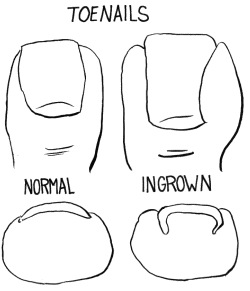Ingrown toenails are common, painful conditions that occur when the skin on the side of a toenail grows over the edge of the nail, or when the nail grows into the skin. Ingrown toenails can develop for many reasons: toenails that are too large; toes that curl (congenitally or from disease such as arthritis); trauma to the toes, such as stubbing a toe or having a toe stepped on; frequent running; incorrectly trimming the nails causing them to re-grow into the skin; by wearing excessively tight socks; or by footwear with narrow toe boxes. Bedridden patients may develop ingrown toenails from bedsheets that are tucked in too tightly.
Signs of this condition include when the skin is red, painful, or swollen on the sides of the nail. The warm, moist environment of socks or shoes may provide a convenient entry for germs that can cause infection. At first, the skin around the nail may be mildly red or inflamed. Untreated, the nail can grow under the skin, causing a severe infection.
Ingrown toenails should be treated as soon as they develop. Soaking the feet in warm soapy or salt water can help to treat them. Drying the feet thoroughly with a clean towel is also very important. Afterward, apply a mild antiseptic solution to the area and bandage the toe. Various over-the-counter preparations are available that can harden the skin and shrink the soft tissue along the edge of the nail so it grows normally. A soft, foam toecap can be worn while the ingrown nail heals.
If excessive inflammation, swelling, pain, and discharge develop, the toenail probably is infected and should be treated by a physician or podiatrist who can trim or remove the infected nail with a minor in-office surgical procedure. A portion of the nail or overgrown skin is removed with a scalpel and the infection is treated. If an ingrown toenail recurs, it may require a more permanent solution by a more involved surgery or burned with a more concentrated chemical.
Unless the problem is congenital, the best way to prevent ingrown toenails is to protect the feet from trauma and wear footwear with adequate room for the toes and socks that do not constrict your toes. View the medical socks selections on WorkingPerson.com. There you will find socks that are non-restricting, which may help prevent ingrown toenails. Lastly, nails should be trimmed straight across with clippers to a comfortable length.




